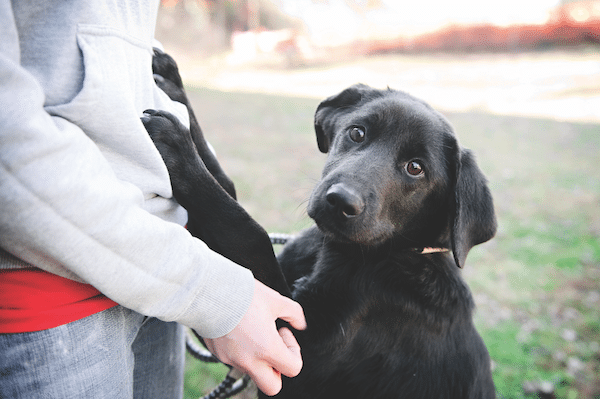Editor’s note: Have you seen the Dogster print magazine in stores? Or in the waiting room of your vet’s office? This article appeared in our February-March issue. Subscribe to Dogster and get the bimonthly magazine delivered to your home.
Chloe’s owners were never able to go out together. She had such severe separation anxiety that for years they made sure one of them was always home with her.
That’s extreme, but fear, anxiety, and stress affect many dogs in seemingly everyday situations. Frightening or painful first experiences or unfamiliarity with a situation can cause them to resist or run from grooming, riding in a car, or going to the vet. That’s not good for a pet’s overall health and happiness.
The Bayer Veterinary Health Care Usage Study found that people whose pets are afraid at the veterinarian don’t want to take them in. Those dogs and their people often “drop out” of veterinary care, said Marty Becker, D.V.M., founder of the Fear Free program. Fear Free certified vets use Fear Free methods to help reduce and remove anxiety triggers for our cats and dogs going to the veterinarian. Find out more about this program or find a Fear Free certified veterinarian near you at fearfreepets.com.
Separation anxiety, nail trims, and veterinary visits are just a few of the items on a dog’s “most unwanted” list. But more and more veterinarians are working to help pet owners recognize, understand, and deal with canine fears. We’ve gathered their top tips on creating a less stressful life for dogs.
Home free
Chloe’s veterinarian, Dr. Jonathan Bloom of Willowdale Animal Hospital in Toronto, suggested a combination of several therapies to help her feel more comfortable when she was home alone.
“A compression shirt is like a nice, tight hug, and it offers reassurance to pets,” he said. He also explained ways to gradually condition Chloe to being alone using food treats, puzzle toys for distraction, and calming music. “We used some anti-anxiety medications as well,” he said.
Now Chloe is able to stay on her own, and her owners can go out together without fear that Chloe is at home having a meltdown. Her medication has been reduced because she has learned that nothing bad happens when her people are away.
Out and about

Woman with dog by Leesia Teh Photography.
It’s not unusual for dogs to be afraid of riding in cars, especially if they usually end with a visit to the veterinarian. Dr. Natalie Marks at Blum Animal Hospital in Chicago had several recommendations for people whose dogs resist road trips.
- First, make short trips to nowhere to give the dog a taste of how uneventful a car ride can be.
- “If your dog has never been in the car before, it’s probably not a good time to try that right before a stressful grooming or veterinary appointment,” she said.
- Secure him in a carrier or with a doggie seatbelt. If he’s not sliding around, he’ll feel more comfortable.
- Wearing a compression shirt may help to provide an added feeling of security.
- “Avoid signs of motion sickness by making sure he’s facing forward and that you have the window cracked a little bit,” she said. That alone can help to alleviate anxiety. Your veterinarian can also prescribe medication to reduce the effects of motion sickness.
- Use a calming pheromone spray in the car, in the dog’s carrier, or on his seatbelt.
When dogs feel less stressed, Dr. Marks said, owners feel less stressed, too. “That’s actually a much more safe travel experience.”
Grooming
It’s not clear who hates nail trims more — dogs or their people. When they go wrong, the screaming and bleeding aren’t pleasant for anyone. Nail trims, tooth brushing, and other grooming tasks don’t have to be a battle. Your dog can learn to love grooming time if you take things slowly and gently.
- First, handle his paws and look at his teeth and ears so he’s used to your touch.
- Schedule grooming for a time when you know your dog will be relaxed, such as after a walk or play session.
- For nail trims, start with one or two nails at a time and barely trim the end so you don’t run the risk of “quicking” him. Gradually, you’ll both become experienced, and it will go more quickly.
- For tooth brushing, start by lifting the lip in different areas to look at the teeth. When your dog is comfortable with that, rub one or two teeth with a gauze-wrapped finger. Eventually, graduate to a finger brush with tasty beef-flavored toothpaste.
Veterinary visits
“We want pets to have a better experience when coming to the vet,” said John Talmadge, D.V.M., of Bigger Road Veterinary Clinic in Kettering, Ohio. That starts with lots of treats when pets come in. Calming pheromones and music help, plus owner training is important, too.
“We are spending more time working with owners to accurately diagnose the different anxiety manifestations and get owners the proper training techniques and, in some cases, anxiety medications to help get their pets over some of the fear and anxiety issues they are experiencing,” Dr. Talmadge said.
Signs of anxiety
Signs of canine fear, anxiety, and stress include:
- yawning
- drooling
- licking lips
- freezing in place
- trembling
- whining
- growling
- biting
The post How Your Dog Can Be Anxiety Free appeared first on Dogster.
No comments:
Post a Comment